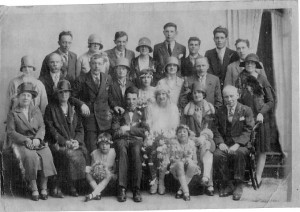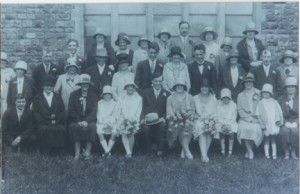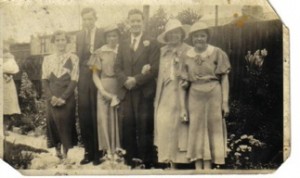[This narrative was written for Week 9 of my creative writing course]
Linchpin of the family
Elizabeth Hacker (nee Hunt) was my great-grandmother. I only know her through black and white photographs and other people’s memories. Most of the photographs show her surrounded by her family, many with my grandparents, mother and aunt. There are two earlier photographs, one of her with her twin brother taken in the back garden of their family home when they were in their late teens, the other a more formal portrait with her mother and first born son.
Beginning
She grew up in a small village called Broad Hinton in Wiltshire during the end of the nineteenth century. She had seven brothers and sisters including her twin brother Charles. Her father was employed as a farm labourer and it seems that many of her brothers followed into this profession.
According to my mother Elizabeth sometimes helped at the vicarage, and also occasionally taught the younger children in the school, as this was allowed in those days.
At some point she became engaged to the local baker. One of her younger brothers was a Bakers Boy (according to the 1891 census) so perhaps they met through him or everyone knew each other in their small village.
Unfortunately on the 7th November 1899 tragedy struck. Her twin brother Charles was shot by her fiancé, Alfred Hacker, whilst they were shooting pigeons and died. Her fiancé was apparently accused of murder but acquitted at the inquest and the cause of death was recorded as “accidentally shot by a pistol”. [Family stories had the incident occurring when the twins were 18 or 21. I eventually ordered a copy of his death certificate so I could be sure of the date. I’ve recently been communicating with the local record office and am waiting to hear what was reported in the local newspaper.]
Two years later Elizabeth married her fiancé on the 7th October 1902 at Broad Hinton Church. The vicars’ wife made her bouquet with orange blossom grown from the vicarage garden. They went to church in a carriage drawn by two white horses. Not bad for a local girl.
Married life
It seems the shooting accident turned my great grandfather to drink. According to family legend when he went round the village to collect payment for his bread deliveries each Friday he began to accept home brew rather than money. Eventually his business went bankrupt and his family had to leave their home and business in Broad Hinton. They are found in the 1911 census in Hilmarton and his occupation is given as journeyman baker rather than the family baker of the 1901 census.
Move to the city
At some point Alfred stopped working as a baker and got a job at the Great Western Railway Works [not sure doing what yet]. He walked the 6 miles from Hilmarton to Swindon and back again every day before the family moved to Swindon. He earned £5 a week but spent half on alcohol and gave half to Elizabeth for rent, bills and food.
Linchpin of the family
Elizabeth had 10 living children and 10 miscarriages. Their move to Swindon was permanent and they were never to return to their roots in the country. They rented a small terraced house where they brought up their family. Out of the surviving children the 4 boys were in one double bed in one room, the 4 girls in one double bed in the other room. This arrangement stayed until the children grew up and left home.
The Great Western Railway Works was the biggest employer in Swindon, peaking at over 14000 in the 1920s. In those days her sons were guaranteed jobs as her husband worked there. Three of her daughters were employed at Wills Tobacco Factory and one at Compton’s clothing manufacturers, all well known Swindon businesses, before they were married.
An undercurrent of sadness continued. Her husband and one of her sons died of TB in 1935.
Her children grew up, got married and left home except the youngest daughter and her family. Elizabeth kept the large front bedroom she had always occupied; her daughter, husband and son sharing one of the smaller back bedrooms. During the Second World War another of her daughters moved back in with her (my grandmother with my mother and aunt) as her husband was away from home in the Army. Fortunately her sons were employed by the Great Western Railway, which meant their occupations were protected.
Her family escaped any major tragedy during this time. Her son in law was on the aircraft carrier Ark Royal when it was torpedoed in 1941 but survived. The Great Western Railway Works became a war factory and a target for German bombers. Swindon was heavily hit and, although bombs fell around the streets that Elizabeth and her family lived, no one was directly hurt.
The End
Elizabeth kept a dairy of which I have the year 1955. Unfortunately the rest were all thrown away after she died. In it she records the daily visits from her children and their families, visits from extended family, the weather and surprisingly notes about the local football team.
Her youngest daughter and family continued to live with her until she died of a stroke aged 70 in 1959.






